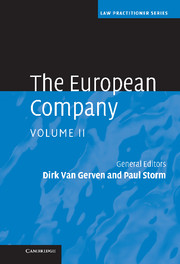2 - Cyprus
from Part II - Application in each Member State
Published online by Cambridge University Press: 06 July 2010
Summary
Introduction
1. EC Regulation No 885/2004 of 26 April 2004 extends to Cyprus the application of Council Regulation No 2157/2001 of 8 October 2001 on the Statute for a European company (the ‘Regulation’) and Council Directive 2001/86/EC of 8 October 2001 supplementing the Statue for a European company with regard to the involvement of employees (the ‘Directive’). The European Public Limited-Liability Company Regulations 2006 (the ‘EPLLC Regulations’) and Law 277(I)/2004 were introduced in order to harmonise Cypriot and Community law. Given that the European company (commonly referred to by its Latin name, Societas Europaea or SE) has only existed since mid-2006, there is as yet no Cypriot case law on the subject.
As noted at no. 2 of the general report, the Regulation and the Directive apply throughout the European Economic Area (EEA), and references in this chapter to the European Union or to its Member States should be construed to include Norway, Iceland and Lichtenstein.
Application
2. Cyprus came under an obligation to bring its legislation into line with the Regulation and the Directive when it acceded to the European Union on 1 May 2004. The EPLLC Regulations facilitate the application of the Regulation and were introduced via Section 387(1)(e) of the Cypriot Companies Law, Chapter 113 (the ‘CCL’).
- Type
- Chapter
- Information
- The European Company , pp. 63 - 84Publisher: Cambridge University PressPrint publication year: 2008

